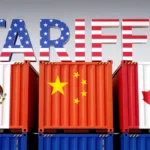Latest Posts
June 30, 2025 Tariffs: The Upside
June 30, 2025
Tariffs: The Upside
June 30, 2025
 Exploring the Role of Intrapreneurs: Innovation Drivers Within Organizations
June 30, 2025
Exploring the Role of Intrapreneurs: Innovation Drivers Within Organizations
June 30, 2025
 Mastering Productivity: A Guide to Being More Effective While Working from Home
Mastering Productivity: A Guide to Being More Effective While Working from Home
Newsletter
Sign up to receive email updates from the Freightpath.
"*" indicates required fields
Understanding the Digital Freight Marketplace: Revolutionizing Logistics and Transportation
June 30, 2025
In recent years, the logistics and transportation industry has undergone a significant transformation with the rise of digital freight marketplaces. These platforms leverage technology and data-driven solutions to connect shippers, carriers, and freight brokers in a seamless and efficient marketplace. Let’s explore the concept, functionalities, benefits, challenges, and future trends of digital freight marketplaces, highlighting their impact on supply chain management and logistics operations.
Introduction to Digital Freight Marketplaces
A digital freight marketplace is an online platform that facilitates the matching of freight transport demand with available capacity, enabling real-time transactions and efficient logistics operations. Unlike traditional methods of freight booking and transportation management, which often involve manual processes and intermediaries, digital freight marketplaces utilize advanced technologies such as artificial intelligence (AI), machine learning, and cloud computing to streamline the process and optimize logistics efficiency.
Evolution of Freight Transportation and Market Dynamics
1. Traditional Freight Brokerage
Historically, freight brokerage involved intermediaries, known as freight brokers, who acted as intermediaries between shippers (companies needing to transport goods) and carriers (transportation providers such as trucking companies). Brokers facilitated freight bookings, negotiated rates, and managed logistics processes on behalf of their clients.
2. Shift Towards Digitalization
The advent of digital technologies has transformed the freight brokerage industry, leading to the emergence of digital freight marketplaces. These platforms leverage digitalization to enhance transparency, efficiency, and accessibility in freight booking and transportation management.
3. Market Dynamics
The digital freight marketplace ecosystem is characterized by dynamic interactions among shippers, carriers, freight brokers, and technology providers. Key market dynamics include competition among platform providers, technological innovation, regulatory considerations, and evolving customer expectations for transparency and efficiency in logistics operations.
Functionality and Key Components of Digital Freight Marketplaces
1. Shipment Booking and Matching
Digital freight marketplaces enable shippers to post their shipment requirements, including origin, destination, cargo type, and preferred delivery timeline. Carriers can browse available shipments and submit bids or accept booking requests based on their capacity and route availability.
2. Real-Time Visibility and Tracking
Enhanced visibility and tracking capabilities allow stakeholders to monitor shipment status, location, and estimated time of arrival (ETA) in real time. This transparency enables proactive management of logistics operations and timely communication with customers and partners.
3. Automated Freight Matching
AI-driven algorithms and machine learning models automate the process of matching freight demand with available capacity, considering factors such as shipment characteristics, carrier preferences, historical performance data, and market rates. This automated matching improves efficiency and reduces manual intervention in freight booking and logistics management.
4. Rate Transparency and Negotiation
Digital freight marketplaces promote rate transparency by providing shippers and carriers with visibility into market rates, competitive pricing trends, and historical transaction data. Transparent pricing facilitates informed decision-making and fair negotiations between parties.
5. Payment and Settlement
Integrated payment and settlement features enable secure and efficient financial transactions between shippers, carriers, and freight brokers. Digital freight marketplaces may offer options for automated invoicing, payment processing, and dispute resolution to streamline financial transactions and improve cash flow management.
Benefits of Digital Freight Marketplaces
1. Enhanced Efficiency and Operational Agility
Digital freight marketplaces streamline logistics operations by reducing manual processes, optimizing resource allocation, and minimizing idle capacity. Automated workflows and real-time data integration improve operational agility and responsiveness to changing market conditions.
2. Cost Optimization
Optimized freight matching and route planning reduce transportation costs, including fuel expenses, maintenance costs, and overhead expenses associated with inefficient logistics practices. Improved efficiency in freight booking and management translates into cost savings for shippers and carriers.
3. Improved Visibility and Transparency
Real-time visibility into shipment status, inventory levels, and logistics performance enhances supply chain visibility and transparency. Stakeholders can make data-driven decisions, mitigate risks, and proactively address operational challenges to improve customer service and satisfaction.
4. Scalability and Flexibility
Digital freight marketplaces offer scalable solutions that can accommodate varying shipment volumes, seasonal demand fluctuations, and evolving business requirements. Flexible integration with existing IT systems and supply chain networks supports growth, expansion, and adaptation to changing market dynamics.
Challenges and Considerations in Adopting Digital Freight Marketplaces
1. Technological Integration
Integration with existing IT infrastructure, legacy systems, and third-party applications requires careful planning and investment in technology upgrades or customization. Compatibility issues and data security concerns may arise during implementation.
2. Data Privacy and Security
Protecting sensitive information, such as shipment details, financial transactions, and customer data, from cybersecurity threats and data breaches is essential for maintaining trust and compliance with regulatory requirements.
3. Market Fragmentation and Competition
The digital freight marketplace ecosystem is characterized by competition among platform providers, varying service offerings, and market fragmentation. Shippers and carriers may face challenges in selecting the right platform that aligns with their business needs and operational requirements.
4. Regulatory Compliance
Navigating regulatory frameworks, transportation regulations, and legal requirements across different jurisdictions requires adherence to compliance standards and industry regulations. Platform providers must ensure transparency, fairness, and accountability in freight transactions to mitigate regulatory risks.
Future Trends and Innovations in Digital Freight Marketplaces
1. Adoption of IoT and Sensor Technologies
Integration of Internet of Things (IoT) devices and sensor technologies for real-time monitoring of shipment conditions, environmental factors, and asset tracking enhances visibility, safety, and efficiency in freight transportation.
2. Blockchain Technology
Blockchain technology enables secure, transparent, and immutable recording of transactional data, contracts, and documentation throughout the supply chain. Smart contracts automate payment settlements, reduce disputes, and enhance trust among stakeholders.
3. Predictive Analytics and AI
Advancements in predictive analytics and AI-driven algorithms enable predictive modeling, demand forecasting, and decision support tools for proactive risk management, capacity planning, and operational optimization in logistics operations.
4. Sustainability Initiatives
Growing emphasis on environmental sustainability and corporate social responsibility (CSR) drives initiatives for carbon footprint reduction, eco-friendly logistics practices, and adoption of green transportation technologies within digital freight marketplaces.
Case Studies and Real-World Applications
Case Study 1: Uber Freight
Explore how Uber Freight leverages technology and data analytics to disrupt the traditional freight brokerage industry, offering real-time freight matching, transparent pricing, and operational efficiency to shippers and carriers.
Case Study 2: Convoy
Learn how Convoy utilizes AI-driven algorithms and digital freight marketplace solutions to optimize trucking operations, reduce empty miles, and improve resource utilization for sustainable logistics practices.
Conclusion
Digital freight marketplaces represent a transformative force in the logistics and transportation industry, offering unprecedented opportunities for efficiency, transparency, and cost savings. By accepting digitalization, leveraging advanced technologies, and adopting collaborative approaches, businesses can streamline freight booking, optimize resource allocation, and enhance supply chain visibility to meet evolving customer demands and market expectations. As the industry continues to evolve, organizations that prioritize innovation, adaptability, and customer-centricity will thrive in an increasingly interconnected and competitive marketplace. We must all embrace the future of logistics with digital freight marketplaces to unlock new possibilities and drive sustainable growth in supply chain management and transportation logistics.
John Delgado
CEO @ FreightPath Inc. | CSCMP Corporate Member | We Deploy The Industry’s Most Comprehensive Global Supply Chain Curriculum | 500+ Course Library | gofreightpath.com/course-catalog
